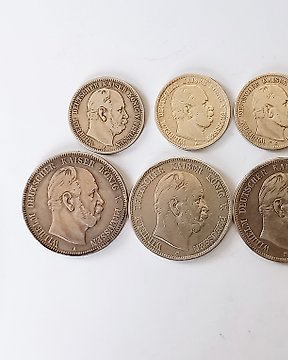
Németország - Poroszország. Wilhelm I. 6 verschiedene Silbermünzen ( 3 x 5 Mark, 3 x 2 Mark) 1876 -1877
Nr. 82487347

Nr. 82487347

Attractive lot with 32 different coins from the 18th and 19th and early 20th century including some high quality and 7 silver pieces.
Please have a look at our other Catawiki auction lots for more coin collections. and/or add us to your favourites to find our future auction lots easily.
Bid with confidence. AG-Worldcoins, over 3000 lots sold on Catawiki. High feedback score.
Please evaluate this lot with reference to the images provided.
Will be sent via registered mail.
I charge only 1x shipping costs when you buy multiple lots in the same auction.
You are welcome to bid on my other items:
https://veiling.catawiki.nl/aanbod/hamaca
Extra Info:
GERMAN STATES
Although the origin of the German Empire can be traced to the Treaty of Verdun that ceded Charlemagne’s lands east of the Rhine to German Prince Louis, it was for centuries little more than a geographic expression, con- sisting of hundreds of effectively autonomous big and little states. Nominally the states owed their allegiance to the Holy Roman Emperor, who was also a German king, but as the Emperors exhibited less and less concern for Germany the actual power devolved on the lords of the individual states. The fragmentation of the empire climaxed with the tragic denouement of the Thirty Years War, 1618-48, which devastated much of Germany, destroyed its agriculture and medieval commercial eminence and ended the attempt of the Hapsburgs to unify Germany. Deprived of administrative capacity by a lack of resources, the imperial authority became utterly powerless. At this time Germany contained an estimated 1,800 individual states, some with a population of as little as 300. The German Empire of recent history (the creation of Bis- marck) was formed on April 14, 1871, when the king of Prussia became German Emperor William I. The new empire comprised 4 kingdoms, 6 grand duchies, 12 duchies and principalities, 3 free cities and the nonautonomous province of Alsace-Lorraine. The states had the right to issue gold and silver coins of higher value than 1 Mark; coins of 1 Mark and under were general issues of the empire.
MINT MARKS
A - Berlin, 1750-date
A - Clausthal (Hannover), 1833-1849
B - Bayreuth, Franconia (Prussia), 1796-1804 B - Breslau (Prussia, Silesia), 1750-1826
B - Brunswick (Brunswick), 1850-1860
B - Brunswick (Westphalia), 1809-1813
B - Dresden (Saxony), 1861-1872
B - Hannover (Brunswick), 1860-1871
B - Hannover (East Friesland), 1823-1825
B - Hannover (Germany) 1872-1878
B - Hannover (Hannover) 1821-1866
B - Hannover (Prussia) 1866-1873
B - Regensburg (Regensburg) 1809
B.H. Frankfurt (Free City of Frankfurt), 1808 B (rosette) H - Regensburg (Rhenish
Confederation) 1802-1812
C - Cassel (Westphalia), 1810-1813
C - Clausthal (Brunswick)
C - Clausthal (Hannover), 1813-1834
C - Clausthal (Westphalia), 1810-1811
C - Dresden (Saxony), 1779-1804
C - Frankfurt (Germany), 1866-1879
D - Aurich (East Friesland under Prussia), 1750-1806 D - Dusseldorf, Rhineland (Prussia), 1816-1848
D - Munich (Germany), 1872-date
E - Dresden (Germany), 1872-1887
E - Muldenhutten (Germany), 1887-1953
F - Dresden (Saxony), 1845-1858
F - Magdeburg (Prussia), 1750-1806
F - Cassel (Hesse-Cassel), 1803-1807
F - Stuttgart (Germany) 1872-date
G - Dresden (Saxony), 1833-1844, 1850-1854
G - Glatz (Prussian Silesia) 1807-1809
G - Karlsruhe (Germany) 1872-date
G - Stettin In Pomerania (Prussia), 1750-1806 GN-BW - Bamberg (Bamberg)
H - Darmstadt (Germany) 1872-1882
H - Dresden (Saxony) 1804-1812
H.K. - Rostock (Rostock) 1862-1864
I - Hamburg (Germany)
J - Hamburg (Germany) 1873-date
J - Paris (Westphalia) 1808-1809
M.C. - Brunswick (Brunswick), 1813-14, 1820
P.R. - Dusseldorf (Julich-Berg), 1783-1804
S - Dresden (Saxony) 1813-1832
S - Hannover (Hannover) 1839-1844
MONETARY SYSTEM
Until 1871 the Mark (Marck) was a measure of weight.
North German States until 1837
2 Heller = 1 Pfennig
8 Pfennige = 1 Mariengroschen 12 Pfennige = 1 Groschen
24 Groschen = 1 Thaler
2 Gulden = 1-1/3 Reichsthaler
1 Speciesthaler (before 1753)
1 Convention Thaler (after 1753)
North German States after 1837
12 Pfennige = 1 Groschen 30 Groschen = 1 Thaler
1 Vereinsthaler (after 1857)
South German States until 1837
8 Heller = 4 Pfennige = 1 Kreuzer
24 Kreuzer Landmunze = 20 Kreuzer
Convention Munze
120 Convention Kreuzer = 2 Convention
Gulden = 1 Convention Thaler
South German States after 1837
8 Heller = 4 Pfennige = 1 Kreuzer
German States 1857-1871
As a result of the Monetary Convention of 1857, all the German States adopted a Vereinsthaler of uniform weight being 1/30 fine pound silver.They did continue to use their regionalminor coin units to divide the Vereinsthaler for small change purposes.
After the German unification in 1871 when the old Thaler system was abandoned in favor of the Mark system (100 Pfennig = 1 Mark) the Vereinsthaler continued to circulate as a legal tender 3 Mark coin, and the double Thaler as a 6 Mark coin until 1908. In 1908 the Vereinsthalers were officially demonetized and the Thaler coinage was replaced by the new 3 Mark coin which had the same specifications as the old Vereinsthaler. The double Thaler coinage was not replaced as there was no great demand for a 6 Mark coin. Until the 1930’s the German public continued to refer to the 3 Mark piece as a “Thaler”.
Commencing 1871 gold
100 Pfennig = 1 Mark
VERRECHNUNGS & GUTSCHRIFTS TOKENS
These were metallic indebtedness receipts used for commercial and banking purposes due to the lack of available subsidiary coinage. These tokens could be redeemed in sufficient quantities.
Hogyan vásárolhatok a Catawiki-n?
1. Fedezzen fel valami különlegeset
2. Tegye meg a legmagasabb licitet
3. Fizessen a biztonságos és védett rendszert használva